It’s no secret that Srila Prabhupada wants the devotees to develop rural communities where they produce their necessities while centering their lives around Krsna. That concept is right in the original articles of incorporation for ISKCON, purpose #6: “To bring the members closer together for the purpose of teaching a simpler, more natural way of life.” Indeed one of the first things that Srila Prabhupada did after starting his movement was to establish the first farm community, New Vrndavana, in West Virginia. And on his death bed, unable to even rise his arm, he spoke about the necessity for people to live in a sattvic environment by associating in a varnashrama community. Many older devotees who had close personal association with Srila Prabhupada have confirmed that Srila Prabhupada considered the establishment of self-sufficient communities based on the concept of simple living and high thinking, and organized according to the principles of varnashram dharma, to be the 2nd half of his mission.”
Here is what Srila Prabhupada said regarding lifestyle:
Prabhupada: If you open farm for financial help, then it will not be successful. You should take to farming for supporting yourself. That’s all. Grow your own food. Grow your own cloth. There is no need of financial help from outside. You get your food grains sufficiently, rice, dahl, wheat, vegetables, milk, sugar. Bas You get everything. From these five, six items you should be economically free. That you have to do, not for trade to get money. Then it will be failure. (Conversation, October 28, 1975)
Let us take a closer look at Srila Prabhupada’s guidelines for how he wants us to live together, insulated from the ways and means of the world. Srila Prabhupada is telling us not to farm for export and financial gain, but only for the purpose of self-sufficiency. “There is no need of financial help from outside”. We should simply grow
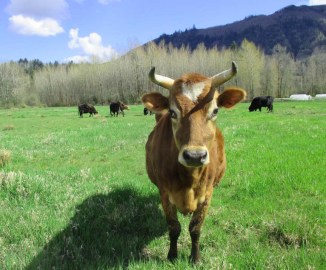 https://newnandagramcowprotection.files.wordpress.com/2017/04/newsletter-042217-013.jpg?w=652&h=542 652w, https://newnandagramcowprotection.files.wordpress.com/2017/04/newsletter-042217-013.jpg?w=150&h=125 150w, https://newnandagramcowprotection.files.wordpress.com/2017/04/newsletter-042217-013.jpg?w=300&h=249 300w" sizes="(max-width: 326px) 100vw, 326px" />
https://newnandagramcowprotection.files.wordpress.com/2017/04/newsletter-042217-013.jpg?w=652&h=542 652w, https://newnandagramcowprotection.files.wordpress.com/2017/04/newsletter-042217-013.jpg?w=150&h=125 150w, https://newnandagramcowprotection.files.wordpress.com/2017/04/newsletter-042217-013.jpg?w=300&h=249 300w" sizes="(max-width: 326px) 100vw, 326px" />Utilizing the assistance of oxen is a foundation of a SLHT lifestyle
food and obtain milk from the cows to supply our own needs, and in that way “you should be economically free”. In other words, we should not be concerned with the accumulation of financial assets. The more we aspire for the acquisitions that are in vogue in the misdirected materialistic society, the more we will compromise the principles of simple living and high thinking. By being satisfied with the simple life that nature provides, we can proceed most directly on the path back to home, back to Godhead. This instruction of Srila Prabhupada has to understood with conviction. As long as we want to have the best of both worlds, we will return here birth after birth. We have to make a sober choice. We go into the world to preach, and for no other reason. But to cultivate our Krishna consciousness in Krishna conscious communities, we are not instructed to integrate, but rather to insulate……..to insulate ourselves from the ways and means of the world, and embrace the life of simple living and high thinking.
Wondering why most devotees haven’t adopted the “simple living high thinking” prescription that Srila Prabhupada has given us, I began looking for explanations by
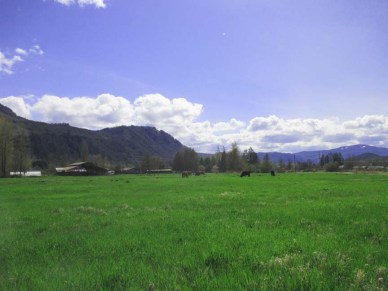 https://newnandagramcowprotection.files.wordpress.com/2017/04/newsletter-042217-018.jpg?w=776&h=582 776w, https://newnandagramcowprotection.files.wordpress.com/2017/04/newsletter-042217-018.jpg?w=150&h=113 150w, https://newnandagramcowprotection.files.wordpress.com/2017/04/newsletter-042217-018.jpg?w=300&h=225 300w, https://newnandagramcowprotection.files.wordpress.com/2017/04/newsletter-042217-018.jpg?w=768&h=576 768w" sizes="(max-width: 388px) 100vw, 388px" />
https://newnandagramcowprotection.files.wordpress.com/2017/04/newsletter-042217-018.jpg?w=776&h=582 776w, https://newnandagramcowprotection.files.wordpress.com/2017/04/newsletter-042217-018.jpg?w=150&h=113 150w, https://newnandagramcowprotection.files.wordpress.com/2017/04/newsletter-042217-018.jpg?w=300&h=225 300w, https://newnandagramcowprotection.files.wordpress.com/2017/04/newsletter-042217-018.jpg?w=768&h=576 768w" sizes="(max-width: 388px) 100vw, 388px" />Our herd of go’s grazing. The goshalla is the large building to the left of center.
asking the devotees I connect with. Many said that devotees simply don’t want to live in that way. Others suggested that devotees who were raised in urban environments were fearful, not knowing where to begin, or if they could make it work. Some were judgmental, saying that fear of arduous labor deterred many from embracing the challenge. And others said that many devotees were out of touch with Srila Prabhupada’s mood since the leaders neither preached nor lived this way of life themselves. One devotee said, “The main problem with starting varashram dharma and simple living is that simple living is not so simple today. It requires money to set up. At least you need a good and sizable farm, which very few can afford. Not only do you need land, but also infrastructure and the cooperation of many expert workers of various kinds.”
I began to contemplate these answers in the light of our personal adventure of adopting Srila Prabhupada’s prescription of simple living and high thinking. And I
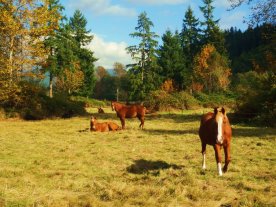 https://newnandagramcowprotection.files.wordpress.com/2014/07/390805_10150432342121014_552516013_10728094_789460863_n.jpg?w=552&h=414 552w, https://newnandagramcowprotection.files.wordpress.com/2014/07/390805_10150432342121014_552516013_10728094_789460863_n.jpg?w=150&h=113 150w, https://newnandagramcowprotection.files.wordpress.com/2014/07/390805_10150432342121014_552516013_10728094_789460863_n.jpg?w=300&h=225 300w" sizes="(max-width: 276px) 100vw, 276px" />
https://newnandagramcowprotection.files.wordpress.com/2014/07/390805_10150432342121014_552516013_10728094_789460863_n.jpg?w=552&h=414 552w, https://newnandagramcowprotection.files.wordpress.com/2014/07/390805_10150432342121014_552516013_10728094_789460863_n.jpg?w=150&h=113 150w, https://newnandagramcowprotection.files.wordpress.com/2014/07/390805_10150432342121014_552516013_10728094_789460863_n.jpg?w=300&h=225 300w" sizes="(max-width: 276px) 100vw, 276px" />Our “free” 9 acre pasture in the Autumn.
thought that maybe if I shared the wonder of our gradual progress down this “road less traveled”, that others would become interested and even encouraged to consider embracing the life that Srila Prabhupada wanted for all of us. After all, he wanted it not only for ourselves, but as a place of refuge for all the beleaguered souls who are lost in the whirlpool of contemporary urban life. So living in this way is not an escape for us, but a practical form of preaching work. Because Krishna consciousness is not just a philosophy, but a way of life. A way of life that is facilitated within a community where simple living and high thinking is cultivated.
I have to admit that we faced some of the same apprehensions that some of my god brothers and god sisters expressed. But now we’re here, on the land. And I can’t help wanting to share some our experiences with you with the hope of whetting your appetite.
How we overcame the logistical barriers to simple living, high thinking
When Billy and I decided to learn to live a self reliant lifestyle in which we produced our necessities, amazingly Krsna arranged for key elements to be dropped in our laps. We would have been very reluctant to go buy a cow and accept the huge
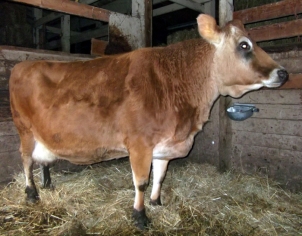 https://newnandagramcowprotection.files.wordpress.com/2018/01/rain.jpg?w=604&h=474 604w, https://newnandagramcowprotection.files.wordpress.com/2018/01/rain.jpg?w=150&h=118 150w" sizes="(max-width: 302px) 100vw, 302px" />
https://newnandagramcowprotection.files.wordpress.com/2018/01/rain.jpg?w=604&h=474 604w, https://newnandagramcowprotection.files.wordpress.com/2018/01/rain.jpg?w=150&h=118 150w" sizes="(max-width: 302px) 100vw, 302px" />Rain, a Jersey who belonged to the Pioneer Farm Museum and the mother of our first cow, Dhana
responsibility that comes with having a milk cow and caring for the resulting offspring. Somehow Krsna arranged that I was asked by the curator of a farm museum to care for their milk cow during the winter when they were closed. Although I envisioned myself, out after dark in freezing blowing rain, huddled under a cow to dutifully milk her twice a day, I agreed because I figured I could endure almost anything if the commitment was only four months. Soon I was milking Rain, a beautiful Jersey, and, to my surprise found that I enjoyed milking in all kinds of weather. Rain’s body heat kept me warm as I sat on a three legged stool that Billy made for me and the rhythmic squeezing of her teats held for me a sort of timeless magic that just felt right. Although Rain was gentle and usually well behaved, she did have a penchant to playfully butt the manure cart with her head when I was cleaning her stall, sometimes resulting in the fragrant patties being strewed. Her first heifer, Dhana, born the following winter when I again cared for Rain, became the matriarch of our current little herd of go’s.
At the time we started our self reliant project, we lived in a neighborhood rather than a farming community. Instead of soil, we had sand and potato rocks because our lot was located next to a stream that apparently ate away the topsoil. We couldn’t move further out in the country because of Billy’s job restrictions, so we resolved to make do and learn what we could about how to achieve a simple living lifestyle. Some of our projects, which can be done in most places, even in cities, included bee keeping, developing micro climates to extend the growing season (hoop houses), composting,
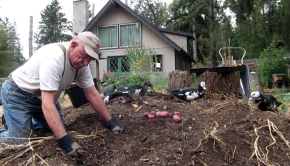 https://newnandagramcowprotection.files.wordpress.com/2018/01/billy-in-garden.jpg?w=580&h=334 580w, https://newnandagramcowprotection.files.wordpress.com/2018/01/billy-in-garden.jpg?w=150&h=86 150w, https://newnandagramcowprotection.files.wordpress.com/2018/01/billy-in-garden.jpg?w=300&h=173 300w" sizes="(max-width: 290px) 100vw, 290px" />
https://newnandagramcowprotection.files.wordpress.com/2018/01/billy-in-garden.jpg?w=580&h=334 580w, https://newnandagramcowprotection.files.wordpress.com/2018/01/billy-in-garden.jpg?w=150&h=86 150w, https://newnandagramcowprotection.files.wordpress.com/2018/01/billy-in-garden.jpg?w=300&h=173 300w" sizes="(max-width: 290px) 100vw, 290px" />Billy digging potatoes behind our former house, located in a neighborhood rather than a farming environment.
starting seeds, seed saving, making medicine from local wild plants, alternative energy, natural construction and preserving the harvest. We also started growing food and enjoyed the results so much that we practically doubled the size of our garden each year, using compost and irrigation to overcome the lack of real soil. We joined and helped grow a community group dubbed “The Self Reliant Community” and with this group promoted educational presentations on topics including alternative currencies, growing grains on a small scale, permaculture, vermiculture, hugelkulture and seed saving.
Synchronicities: mystical coincidences
One interesting thing that both Billy and I have noted during our journey to learn self reliance is the mystical aspect. It seemed that Krsna arranged “coincidences” to help us in each step of our path. Not only were we given the opportunity to care for a cow without full commitment, but when we had obstacles, the solutions would tend to manifest. For instance because we have a short growing season and typically cool summers, if we wanted to be able to grow warm-loving vegetables such as tomatoes and eggplant we needed to create a warmer micro climate using a frame covered by a transparent material such as greenhouse plastic. For our first effort we purchased PVC pipe and plastic sheeting at the hardware store and erected a 20′ hoop house that
 https://newnandagramcowprotection.files.wordpress.com/2018/01/collapsed-hoop-house.jpg?w=150&h=113 150w, https://newnandagramcowprotection.files.wordpress.com/2018/01/collapsed-hoop-house.jpg?w=300&h=225 300w, https://newnandagramcowprotection.files.wordpress.com/2018/01/collapsed-hoop-house.jpg 576w" sizes="(max-width: 327px) 100vw, 327px" />
https://newnandagramcowprotection.files.wordpress.com/2018/01/collapsed-hoop-house.jpg?w=150&h=113 150w, https://newnandagramcowprotection.files.wordpress.com/2018/01/collapsed-hoop-house.jpg?w=300&h=225 300w, https://newnandagramcowprotection.files.wordpress.com/2018/01/collapsed-hoop-house.jpg 576w" sizes="(max-width: 327px) 100vw, 327px" />Our first (collapsing) hoop house.
was large enough for me to stand in and to grow dozens of tomato plants. That year, for the first time we had tomatoes and I even had enough to can them so that we could avoid buying tomatoes during the rest of the year. Unfortunately the PVC hoop house didn’t work out too well because the design had places that allowed rainwater to accumulate and the weight of the water stressed the structure to the point that just a little wind collapsed the whole thing. Coincidentally a neighbor gave me the frame from an old Costco carport, that had come with a fabric covering (her covering had worn out). This frame, covered with UV protected plastic purchased from a agricultural supplier created a micro climate that could be used for years and could withstand our weather. And also coincidentally, I was able to reciprocate with this neighbor, who had expressed a desire to keep bees, by giving her a hand-made topbar beehive made by Billy and his friend, Jerry.
Another coincidence happened when I heard Srila Prabhupada, in a class, talk about the various ways that people could travel through the air. Of course he mentioned vimanas (airplanes) and travel by mystic power, but he also said that formerly people would train pigeons and be able to fly using pigeons. I have been fascinated with pigeons since I was a girl growing up in London where I’d entice pigeons landing on a ledge outside my bedroom window to eat from my hand. I thought it might be nice to keep a few pigeons for a future situation where communications might have to be conducted by alternative means. Pigeons will fly home, even from hundreds or thousands of miles and have been a reliable form of communications during times of war as recently as WW2.
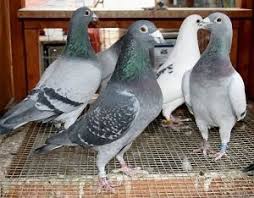 https://newnandagramcowprotection.files.wordpress.com/2018/01/pigeons.jpg?w=150 150w" sizes="(max-width: 254px) 100vw, 254px" />A short time later, the man who would come to AI (artifically inseminate) our cow happened to mention that he races pigeons as a hobby. I asked him if he had any extra and was very surprised when he dropped off 5 squeakers (newly fledged pigeons), just a few days later, leaving the box on our door-step because we were out at the time. We scrambled to build a loft and the next time I saw Wayne I was able to give him a beautiful 5 gallon metal milk can that was purchased through craigslist ($20) that somehow had his name, Cambra, already engraved on it. The can had originally come from Portugal and apparently Cambra is a common Portuguese name.
https://newnandagramcowprotection.files.wordpress.com/2018/01/pigeons.jpg?w=150 150w" sizes="(max-width: 254px) 100vw, 254px" />A short time later, the man who would come to AI (artifically inseminate) our cow happened to mention that he races pigeons as a hobby. I asked him if he had any extra and was very surprised when he dropped off 5 squeakers (newly fledged pigeons), just a few days later, leaving the box on our door-step because we were out at the time. We scrambled to build a loft and the next time I saw Wayne I was able to give him a beautiful 5 gallon metal milk can that was purchased through craigslist ($20) that somehow had his name, Cambra, already engraved on it. The can had originally come from Portugal and apparently Cambra is a common Portuguese name.
While watching my pigeons fly in a flock in large loopy circles, I’d occasionally wonder how they could be trained to carry humans from place to place. Then one day I had a flash of serendipity as I watched a hang glider jump off of Dog Mountain behind our
 https://newnandagramcowprotection.files.wordpress.com/2018/01/hang-glider-with-pigeons.jpg?w=150 150w, https://newnandagramcowprotection.files.wordpress.com/2018/01/hang-glider-with-pigeons.jpg?w=300 300w" sizes="(max-width: 400px) 100vw, 400px" />
https://newnandagramcowprotection.files.wordpress.com/2018/01/hang-glider-with-pigeons.jpg?w=150 150w, https://newnandagramcowprotection.files.wordpress.com/2018/01/hang-glider-with-pigeons.jpg?w=300 300w" sizes="(max-width: 400px) 100vw, 400px" />Photo courtesy of Photoshop
property: the pigeons could be harnessed to a hang glider-type of chariot and could pull a brave person. Pigeons, which can fly 40 mph. are easily trained to follow a flag attached to a bamboo pole, so the charioteer could simply guide them from behind using a flag. I googled “pigeon harness” and there are already harnesses for pigeons, apparently.
Economic Reality
One of the biggest logistical hurtles in trying to live a SLHT lifestyle is the reality that if you purchase property and have a mortgage, you’ll likely have to spend a good portion of your time and energy making enough Federal Reserve Notes to be able to pay the mortgage. The entanglements in business or a job necessarily interfere with a simple lifestyle. Ideally a devotee community would include cottage industry or other economic opportunities enabling a mortgage to be satisfied within the SLHT framework, but in the absence of such opportunities, devotees who want to ease themselves into the lifestyle could continue in their economic realities while learning self reliant skills, as we did.
Interestingly, several years after embarking on our journey to learn self reliance, Krsna arranged for Billy to suddenly and unexpectedly to become unemployed. He was our main breadwinner, and had reached an age where it was looking like it might be difficult for him to find an appropriate job to satisfy our requirements. We were even facing the real possibility of losing our property once his unemployment benefits ran out. This was in 2011, the height of the Great Recession, so my skill set in sales (I’ve done RV sales and real estate as well as book sales) didn’t seem to provide the solution to our problems. We figured if we could purchase a property using just the equity we had in our current home that we could use Billy’s social security to pay for modern “necessities” such as taxes and phone service and pursue a SLHT lifestyle full time.
We’d had some mystical experiences in an area (long story) about 50 miles further into the Cascade Mountains from our present home, and one spring day, I set out, without Billy because he is unwilling to trespass on abandoned property, to look for a fixer upper that might be purchased in our price range. I happened to drive by a property that was overgrown with grass. It had an empty-looking barn right on the road and I could see that some of the windows were boarded up. I drove through the open gate and found a photocopied name and phone number taped to the inside of one of the windows of the house, which I noted. The property seemed to be about 5 acres, had a modest house, a large covered arena, two large barns and other outbuildings. It seemed ideal, so I went home and called the number which was answered by a real estate agent. She confirmed that the property was for sale and had been foreclosed. The price was $79,000 as is, which was within our price range. The “as is” part might have been a challenge for many people, but Billy had a lifetime of experience in the construction business and we were up for the challenge. Four months later, we had sold our home (in a very poor market), paid cash ($72,000) for our new 5 acre property
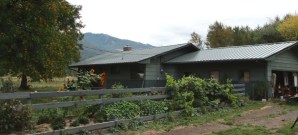 https://newnandagramcowprotection.files.wordpress.com/2018/01/new-camera-032.jpg?w=596&h=272 596w, https://newnandagramcowprotection.files.wordpress.com/2018/01/new-camera-032.jpg?w=150&h=68 150w" sizes="(max-width: 298px) 100vw, 298px" />
https://newnandagramcowprotection.files.wordpress.com/2018/01/new-camera-032.jpg?w=596&h=272 596w, https://newnandagramcowprotection.files.wordpress.com/2018/01/new-camera-032.jpg?w=150&h=68 150w" sizes="(max-width: 298px) 100vw, 298px" />Our house, painted and with a new roof.
and moved. We were finally mortgage free and living in an almost ideal property with ample space under cover for our projects and cows, rich volcanic soil and a house with potential. The only thing that wasn’t perfect was that at 5 acres, the acreage was a too small to support a herd of 10 cows, which is the number of cows that will eventually be the result of breeding a cow every two years to keep a supply of milk.
Miraculously, a few days after we’d moved, the real estate agent stopped by to inform us that there was something important we needed to know about our new home. She urged us to get out the deed and look at it again. Then she showed us where it indicated the transfer of ownership of Parcel A and Parcel B. Parcel B was a 9 acre
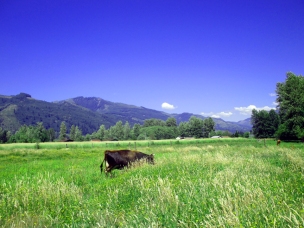 https://newnandagramcowprotection.files.wordpress.com/2014/07/img_0027.jpg?w=608&h=456 608w, https://newnandagramcowprotection.files.wordpress.com/2014/07/img_0027.jpg?w=150&h=113 150w, https://newnandagramcowprotection.files.wordpress.com/2014/07/img_0027.jpg?w=300&h=225 300w" sizes="(max-width: 304px) 100vw, 304px" />
https://newnandagramcowprotection.files.wordpress.com/2014/07/img_0027.jpg?w=608&h=456 608w, https://newnandagramcowprotection.files.wordpress.com/2014/07/img_0027.jpg?w=150&h=113 150w, https://newnandagramcowprotection.files.wordpress.com/2014/07/img_0027.jpg?w=300&h=225 300w" sizes="(max-width: 304px) 100vw, 304px" />Parcel B made our property perfect
parcel with a barn located on Belcher Rd., a street just North and perpendicular to Anderson Rd., where our house was located. Apparently, unknown to our agent, two parcels had been transferred and we’d bought 14 acres when we thought we’d only bought 5. The extra 9 acres, accessible from the home property by a gate, a gift from Krsna, made the property perfect.
We feel that Krsna has helped us on every step of the way the moment we decided to pursue the SLHT lifestyle and have no reason to doubt that he’d similarly help anyone else who commits to take up this task for Srila Prabhupada. Billy and I had no savings and were living paycheck to paycheck, never seeming to be able to get ahead. Within a few short years we were mortgage free, living an ideal lifestyle on an ideal property with wonderful cows.
The Simple Living, High Thinking Lifestyle is a Building Block Towards Varnashrama
A SLHT lifestyle is not varnashrama, but rather a building block on which varnashrama can be built. To try to implement Srila Prabhupada’s desire to develop varnashrama communities, we needed to attract like minded devotees. We felt that if devotees would come and get their own properties nearby, within easy walking distance that eventually a varnashram community would emerge.
There are many things about our valley, Glenoma, that make it ideal for having a varnashram community:
- Property is very affordable compared to almost anywhere else in Western Washington state.
- The land in the valley floor has rich volcanic soil, perfect for growing food.
- The climate is mild with winters rarely having days where it stays below freezing and fairly cool summers having an average temperature of 75º.
- It could be easy to defend, being surrounded by mountains and only accessible from 2 places.
- An ample water supply is not a problem because of an extremely high water table. Most of the year, digging a 3′ fence post hole is equivalent to digging a well. Our own well is only 6′ deep and we’ve never run out of water.
Using these wonderful aspects of our valley as selling points, I set out to attract
 https://newnandagramcowprotection.files.wordpress.com/2017/05/newsletter-051417-013.jpg?w=676&h=506 676w, https://newnandagramcowprotection.files.wordpress.com/2017/05/newsletter-051417-013.jpg?w=150&h=113 150w, https://newnandagramcowprotection.files.wordpress.com/2017/05/newsletter-051417-013.jpg?w=300&h=225 300w" sizes="(max-width: 338px) 100vw, 338px" />
https://newnandagramcowprotection.files.wordpress.com/2017/05/newsletter-051417-013.jpg?w=676&h=506 676w, https://newnandagramcowprotection.files.wordpress.com/2017/05/newsletter-051417-013.jpg?w=150&h=113 150w, https://newnandagramcowprotection.files.wordpress.com/2017/05/newsletter-051417-013.jpg?w=300&h=225 300w" sizes="(max-width: 338px) 100vw, 338px" />I chant my rounds daily near Riffe lake which is about a half mile away from our farm.
devotees to move here. Soon there were 3 devotees interested and amazingly Krsna arranged that they each bought adjacent 5 acre properties that were about a quarter mile from our place. We thought we were well on our way to establishing a community. We thought.
Unfortunately none of the 3 devotees were actually interested in living a SLHT lifestyle. While they were willing to give some help, either financially or physically, it soon became apparent that none of them wanted to produce their necessities, but preferred to continue the lifestyle they’d always had by getting their food at the grocery store and living a lifestyle based on Federal Reserve Notes, rather than the bounty of nature.
Once, as things were becoming increasingly strained with our devotee neighbors, I happened to say to one of them something like: “by producing our own food, I feel like I’m getting a glimpse of the mode of goodness.” The devotee scoffed in reply, “you’re not in the mode of goodness!” Of course I hadn’t claimed to be in the mode of goodness, rather that I was getting a glimpse of it, but his reply did get me to pondering the real reason that it is so hard to get devotees to take up a SLHT lifestyle: they don’t actually believe Srila Prabhupada when he tells us that the lifestyle will make us happy.
I was telling the truth when I said that I was getting a glimpse of the mode of goodness. While I’m certainly not in the mode of goodness, the realizations that I’ve had while pursuing this lifestyle could and may fill a book. This includes realizations about health, medicine, mystic powers, animal communication, economics, astrology, psychology as well as spiritual realizations that have helped me open up my heart to Krsna and Srila Prabhupada. The lifestyle really is the solution to everything. This brings me to the next part of this article, and the answer to the question in the title: the real reason that the second half of Srila Prabhupada’s mission isn’t being implemented is because of the huge psychological barriers in devotees that won’t allow them to even try SLHT.
The Psychological Barriers to Simple Living, High Thinking
Requires special facility:
We have a devotee friend (we’ll call him Krsna das) who is a great proponent of developing the 2nd half of Srila Prabhupada’s mission and he’ll talk at length about his plans to buy several hundred acres and put up a quonset hut manufactured by a company in Canada that has the most perfect, maintenance-free building available anywhere. This nice devotee, who enthusiastically distributes books at a table in Seattle in his free time, is not independently wealthy but he and his wife work hard to maintain a middle class lifestyle and put their children through college. For him to buy and develop a big property as he dreams, would require both him and his wife to work full time to pay for the investment. And it couldn’t realistically be done until all 5 children where out of college, at which time they might be too old to start such an ambitious project.
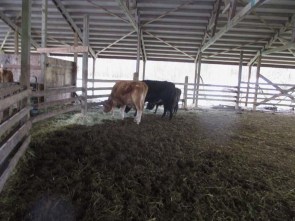 https://newnandagramcowprotection.files.wordpress.com/2017/03/newsletter-march-10-2017-038.jpg?w=590&h=442 590w, https://newnandagramcowprotection.files.wordpress.com/2017/03/newsletter-march-10-2017-038.jpg?w=150&h=113 150w, https://newnandagramcowprotection.files.wordpress.com/2017/03/newsletter-march-10-2017-038.jpg?w=300&h=225 300w" sizes="(max-width: 295px) 100vw, 295px" />
https://newnandagramcowprotection.files.wordpress.com/2017/03/newsletter-march-10-2017-038.jpg?w=590&h=442 590w, https://newnandagramcowprotection.files.wordpress.com/2017/03/newsletter-march-10-2017-038.jpg?w=150&h=113 150w, https://newnandagramcowprotection.files.wordpress.com/2017/03/newsletter-march-10-2017-038.jpg?w=300&h=225 300w" sizes="(max-width: 295px) 100vw, 295px" />The goshalla may not win any architectural awards, but it keeps the cows dry in the winter.
Once when I was explaining to Krsna das that he could begin to develop simple living skills by growing food on his five acre property, he brushed off that suggestion as being irrelevant. He made it clear that he had to do the big project with fancy, perfectly maintained buildings and facilities. When he visited our place, he even advised that we recycle (tear down) our 108′ x 72′ goshalla because it looked to him to be unfinished. The goshalla is a pole barn and although it has a round pen corral and some walls to shield the wind, it is basically open on the sides. It has a new looking metal roof, but it is admittedly not an architectural triumph and is the largest building in the valley.
Krsna das doesn’t understand that the SLHT lifestyle is not about having enviable possessions, it is about making life simple while relying on the bounties of Krsna’s natural arrangements. While Billy and I are grateful and appreciative of the utility of our large eyesore of a goshalla, Krsna das would be embarrassed to the point that if he were in our situation he’d either take on more debt to finish the building or he’d tear it down. And he’d go into additional debt to import a quonset hut home rather than do as Srila Prabhupada instructed and build using materials that nature provides freely in a given area. Krsna das demonstrates an attitude of very rigid thinking that will probably mean that he will never take to a SLHT lifestyle unless it is forced on him by external circumstances.
“It isn’t preaching”
Krsna das also demonstrates another attitude that is a huge impediment towards being able to adopt a SLHT lifestyle. He told me and Billy that what we’re doing here “isn’t preaching.” He thinks that preaching means being at a book table selling Srila Prabhupada’s books or going on harinam. This attitude is another psychological barrier that needs to be overcome. A devotee sent me an article written by Dhanesvara Prabhu with an excellent analysis of this type of thinking:
“There exists a very strong idea amongst some that by distributing books (and perhaps harinam as well) everything else will come, since Srila Prabhupada said as much. Therefore we need only continue the mission in the same fashion as when Srila Prabhupada was with us. There is no need for varnashrama dharma. Harinam and book distribution is all that is needed.
This reminds me of the story wherein during terrible weather and flood a Christian man prayed to the Lord for His help, and was told by God that He would save him. As the water rose the man took to his roof and a boat came by. The man refused to get in saying that “God said He would save me.” Then another boat came by and again the man refused saying “God said He would save me.” Finally as the water was cresting the roof a helicopter tried to hoist him up to safety but again the man refused saying that God would save him. Well, he drowned. When he got to the pearly gates he asked God why he didn’t save him. God replied that He sent two boats and a helicopter but the ignorant fool had refused them.
As a result of book distribution and harinam we can expect to see men of ability come forward to do the needful to establish the entire Krishna varnashrama culture, but they must be recognized as the agents who are going to develop that “everything else.” We should recognize and accept their efforts understanding that they have been sent by the Lord to further the mission. Unfortunately, those who endeavor to expand upon that which was begun by Srila Prabhupada (i.e., varnashramites) are sometimes seen as unnecessary, idle dreamers.”
Toiling in the hot sun
Another psychological barrier that needs to be overcome is the belief that a SLHT lifestyle is very hard physical work. This belief persists even when Srila Prabhupada clearly states that producing one’s own food is simple and need only consume a few months labor with the rest of the time being free for spiritual pursuits. I recently received an e-mail from an older, apartment dwelling devotee, who strongly objected to my assertion that the SLHT could be accomplished by older devotees. He said it was impractical unless they had younger devotees to do the heavy lifting and to drive them around.
I can assure my elderly friend that very little driving is needed in the SLHT lifestyle. Billy and I have developed an extreme aversion to going to town, preferring, if we really need something purchased from the outside (such as ink for the printer) to have
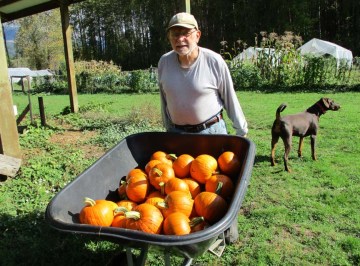 https://newnandagramcowprotection.files.wordpress.com/2018/01/new-camera-056.jpg?w=720&h=532 720w, https://newnandagramcowprotection.files.wordpress.com/2018/01/new-camera-056.jpg?w=150&h=111 150w, https://newnandagramcowprotection.files.wordpress.com/2018/01/new-camera-056.jpg?w=300&h=222 300w" sizes="(max-width: 360px) 100vw, 360px" />
https://newnandagramcowprotection.files.wordpress.com/2018/01/new-camera-056.jpg?w=720&h=532 720w, https://newnandagramcowprotection.files.wordpress.com/2018/01/new-camera-056.jpg?w=150&h=111 150w, https://newnandagramcowprotection.files.wordpress.com/2018/01/new-camera-056.jpg?w=300&h=222 300w" sizes="(max-width: 360px) 100vw, 360px" />These pumpkins are delicious and will keep for a year.
Amazon deliver it. Neither of us have visited a doctor in a decade and Billy, at 75, just put a new metal roof on our house, by himself. As for heavy lifting, food can be produced with a minimum of heavy labor and it is possible to grow everything you need without ever lifting more than 30lbs. Seeds are very light, water hoses are manageable and the harvest can be brought in via hand carts in any amount desired, although in our area you might have to avoid growing hubbard squash that can approach 50lbs. The only real heavy thing is spreading compost/manure, and again that can be managed in smaller loads, if necessary.
Financial Considerations
According to Srila Prabhupada, devotees should be satisfied with what comes naturally:
“A wise man, however, learns from the sastras and guru that we living entities are all eternal but are put into troublesome conditions because of associating with different … under the laws of material nature. He therefore concludes that in the human form of life he should not endeavor for unnecessary necessities, but should live a very simple life, just maintaining body and soul together. Certainly one requires some means of livelihood, … is the basic principle of Vedic civilization. One should be satisfied with whatever means of life comes automatically. The modern materialistic civilization is just the opposite of the ideal civilization. … the so-called leaders of modern society invent something contributing to a cumbersome way of life that implicates people more and more in the cycle of birth, death, old age and disease.” (Srimad-Bhagavatam 7.14.5 Purport)
As disciples and followers of Srila Prabhupada, we should make an effort to believe him when he tells us that the way to happiness is to associate within the mode of goodness.
Conscious Propaganda
I believe that there has been a conscious effort by the demons in control to manipulate American’s attitude against farming. Edward Bernays, a nephew of Sigmund Freud and probably the most evil genius of the 20th century, wrote a book titled Propaganda that details how to achieve agendas to influence people’s behavior. For instance, when approached by the tobacco companies who were lamenting the loss of half of their potential customers due to the social taboo against women smoking in public, Bernays slyly launched a psychological campaign. He paid a group of debutantes to publicly light up cigarettes during an Easter Parade, dubbing the cigarettes “freedom torches” and linking them to the women’s rights movement. The taboo against women smoking literally went up in flames and the tobacco companies reaped the rewards.
I have also long believed that farming was physically draining and economically unsatisfying considering the amount of work involved. This belief was probably planted in Hollywood horse operas that I saw as a child that might depict a young Billy-Joe sweating behind a team of lathered mules, trudging with every step under the hot sun. Later in the movie, poor Billy-Joe would be seen eating meager slop served in a coarse bowl. It was enough to make anyone prefer the happy, exciting life depicted in town with the piano player, the fiddler and the hero who rescues the damsel in distress. It would be right in line with Bernay’s methods to influence Hollywood to produce movies that denigrated farming while glorifying city life. Over the course of a few decades, it would become difficult to find anyone interested in a life that they believed was unrewarding drudgery.
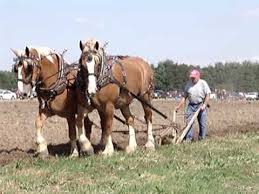 https://newnandagramcowprotection.files.wordpress.com/2018/01/horse-plow.jpg?w=150 150w" sizes="(max-width: 259px) 100vw, 259px" />
https://newnandagramcowprotection.files.wordpress.com/2018/01/horse-plow.jpg?w=150 150w" sizes="(max-width: 259px) 100vw, 259px" />Typical Belgian horses (not my picture)
I discovered the truth about plowing one day when Billy and I attended the annual horse plowing event at a local CSA (Community Sponsored Agriculture). There were about 8 teams of horses plowing a several acre field and spectators were welcome. I followed one teamster and his team of Belgians (huge, big-boned blonds with feathery feet), asking him so many questions that he finally asked if I’d like to try plowing. He guided the horses while my job was to steer the plow handles to create a straight, evenly deep furrow. The challenge was that, unlike driving a car where if you steer right, the car goes right, with a plow, if you tilt to the right the plow cuts to the left. The same with up and down: if you steer up, the plow digs in and if you steer down, the plow cuts closer to the surface.
The soil was perfect, having been planted with winter oats, the weather was mild, dry and overcast and the horses were walking along at a very fast clip. With every step
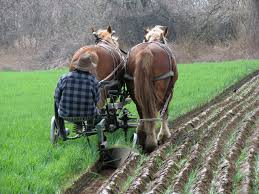 https://newnandagramcowprotection.files.wordpress.com/2018/01/furrow.jpg?w=150 150w" sizes="(max-width: 259px) 100vw, 259px" />
https://newnandagramcowprotection.files.wordpress.com/2018/01/furrow.jpg?w=150 150w" sizes="(max-width: 259px) 100vw, 259px" />The plow turns the soil over in nice even rows.
the grassy green matter would be curled upside down, ideally in a straight, even row. Because we were going quite fast, I’d correct the wrong way and the horses just continued on, resulting in a wavy furrow that was socially awkward because the team behind us had to sort out my mess. But it was great fun and we later were able to share prasadam with the teamsters and talk about the experience. Myth busted: plowing is not drudgery, it is very fun and challenging. It is also done in the spring and fall, times when it is cool.
Draconian Policies
Government policies also contribute to people shying away from farming, particularly avoiding keeping a milk cow. As a child in Portland, Oregon in the early 60s, I remember every year visiting the neighborhood dairy with our school class. We’d get to squeeze a teat and see how the milk was collected. It was a commercial dairy and probably milked about 50 cows. Today due to expensive regulations requiring special manure handling, small dairies are going out of business while the number of large and mega large diaries are increasing. Wayne Cambra (the AI guy with the pigeons) told me that he used to be fully occupied traveling to dozens of small dairies to perform his service, but now has very few customers.
Government regulations also serve to severely discourage anyone who’d just like to keep a family milk cow. A cow usually gives more milk than can be consumed by a family, so it is natural to sell the surplus. In our state, Washington, anyone who sells, barters or even gives away milk from their own cow is breaking the law. They’ve even enacted laws against people who tried “cow share” strategies to go around the draconian milk laws. Basically a person has to be willing to be criminal if he/she wants to keep a family cow.
Vision for the Future
SLHT isn’t varnashrama, but if a group of devotees who are practicing SLHT live in reasonable proximity, it is very likely that varnashrama would develop, especially because we’ve experienced that Krsna seems to amplify any small effort we make towards this goal. We were talking with Hansadutta Prabhu, one of Srila Prabhupada’s first disciples, recently, and he’s been very encouraging to us about our project. He stresses that the lifestyle and eventually varnashrama are paramount to Srila Prabhupada’s mission. Hansadutta Prabhu thinks, however, that the older devotees will not be the ones to implement SLHT and varnashrama. He thinks we need to attract young people who have been born into the chaotic materialistic civilization and who see the need to get back to reality.
We listed our project with WWoof.org and have been amazed with the number of young people who have responded and want to live and work on our farm in exchange for room and board. I’m very open in our description of the project on the Wwoof site, explaining about Srila Prabhupada’s vision and cow protection and our policies against meat eating and intoxication, yet still I’m getting numerous contacts from interested people. I’m certain that as soon as we are able to offer guest accommodations we’ll be able to select from applicants and choose wwoofers whose life goals most closely match Srila Prabhupada’s vision for SLHT. If Krsna sends us devotees in this way, we’ll soon have the building blocks on which to build a genuine varnashrama community which will hopefully attract older devotees to serve in capacity of brahmanas.
As a side note to anyone reading this article and who is looking for a project to support that he/she knows will please Srila Prabhupada, please consider supporting our project. The reality is that keeping cows in a SLHT situation that is not supported by a varnashrama community means that they are a financial liability. We pay a neighbor farmer over $5,000/year on hay to feed our nine cows because the economic reality is that for an isolated couple to keep cows, they are an economic burden. The solution, we believe, is to attract young people/devotees who will work the oxen and eventually take over their maintenance as they also become established living a SLHT lifestyle. Until then, we seriously need financial help.
We have three teams of trained oxen who are ready, willing and able to work for their
 https://newnandagramcowprotection.files.wordpress.com/2017/04/yokw.jpg?w=712&h=658 712w, https://newnandagramcowprotection.files.wordpress.com/2017/04/yokw.jpg?w=150&h=139 150w, https://newnandagramcowprotection.files.wordpress.com/2017/04/yokw.jpg?w=300&h=277 300w" sizes="(max-width: 356px) 100vw, 356px" />
https://newnandagramcowprotection.files.wordpress.com/2017/04/yokw.jpg?w=712&h=658 712w, https://newnandagramcowprotection.files.wordpress.com/2017/04/yokw.jpg?w=150&h=139 150w, https://newnandagramcowprotection.files.wordpress.com/2017/04/yokw.jpg?w=300&h=277 300w" sizes="(max-width: 356px) 100vw, 356px" />Torus and Makani, yoked and ready to work
keep, but lack the manpower to put them to work. Miraculously we have a huge shipping container parked on our property that is full of ox drawn implements, belonging to Rishi Kumar Prabu who is unable to live here at this time. These implements could be used and, with the right manpower, we could provide ecotours and ox cart rides to tourists which could further attract people to SLHT and varnashrama.
Varnashrama communities are going to happen because it is Krsna’s desire. If we choose to assist Krsna and Srila Prabhupada in establishing them, it is a joyful and easy way to please Krsna. Any devotee reading this who is unable to physically participate, please consider sending a donation to help support the cows and to help develop guest quarters so that we can accommodate people who want to experience the lifestyle. We’re developing a plot plan and budget for our ideas that we’d be happy to discuss. Please contact us if you are interested: anuttamadd@gmail.com
We would also love to have devotees come an spend some time with us and possibly experience a bit of the lifestyle for themselves. If you come, you can expect prasadam prepared from ingredients produced on our farm such as cheddar cheese, tomatoes, squash, basil and peppers as well a treats that our Deities enjoy such as shrikhand and walnut burfi. Information about how to contact us to arrange a visit is below.
Conclusions
While a SLHT lifestyle may seem difficult to achieve, Billy and I can testify that because Krsna wants us to take up this lifestyle that He will likely assist anyone who attempts it, even if it is attempted in small, gradual steps as we are doing. Waiting for the “big project” to emerge is not necessary: anyone can start by growing some of his own necessities and by learning basic self reliant skills such as bee keeping, medicinal herbs, seed saving and alternative construction.
The big challenge in taking up a SLHT lifestyle with the goal of establishing varnashrama is psychological. Because of our conditioning, we tend not to believe that living simply and providing our own necessities by the bounty of nature will make us happy, even though our spiritual master assures us that it will. Propaganda by the powers that be as well as an inherent desire to prosper materially are serious impediments that can be combated by sincere sadhana, good association and faith.
I urge anyone reading this to forward it to friends, post it on websites or social media (I’ve recently quit Facebook). Also please send us your comments and ideas and if possible support. Or arrange a visit by contacting us through ur websites: https:// newnandagramcowprotection. wordpress.com/ and https://billyandanuttama. wordpress.com/ e-mail:anuttamadd@gmail.com Or call: 360-496-0058 Not to use fear as a motivator, but the world situation is heating up and at any time the world war predicted by Srila Prabhupada could erupt. Simple living, high thinking and varnashrama could not be more timely.
Comments